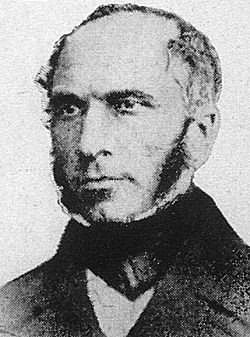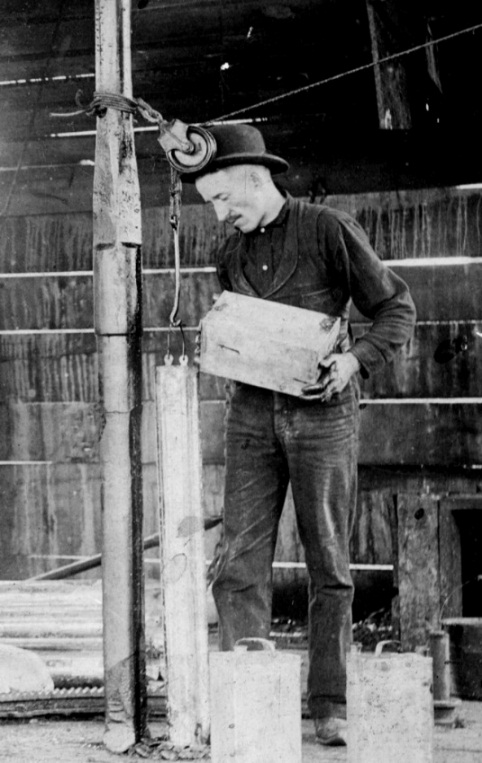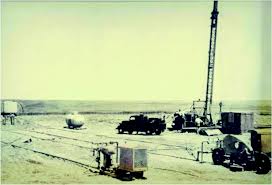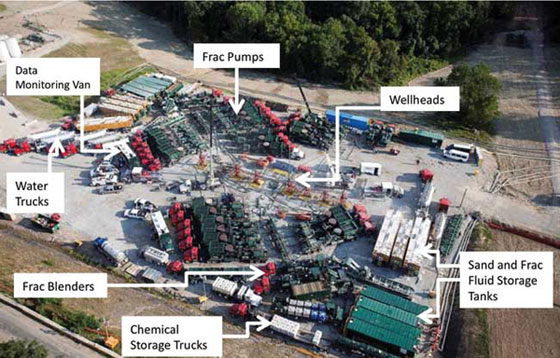Hydraulic Fracturing
Today, we crack rocks. The University of Houston presents this series about the machines that make our civilization run, and the people whose ingenuity created them.
Early nineteenth century French engineer Henry Darcy worked in and around the city of Dijon where he designed and built an ingenious water supply system, roads, bridges, sewers — even a railway tunnel. In 1855, near the end of his life and in poor health, he did experiments on the pressure needed to force water through sand.
We call materials like sand "porous" because the fluids pass through small spaces between the grains. Darcy saw the importance of a quality of porous solids called permeability — how easily fluids can move through those spaces. His formula, Darcy's Law, relates the solid's permeability and the liquid's flow rate to the pressure needed to force it through. Today, engineers express permeability in units of darcies, in honor of his many contributions to our knowledge of fluid flow.

Henry Darcy (1808 — 1853). [Wikipedia Commons]
Permeability is important in oil production, because oil occurs in porous rocks. Many have high permeabilities and can produce at tremendous flow rates. Do you remember the great "gushers" that once occurred when we struck oil? But many more have low permeability and their wells can't produce on their own. As early as 1860, oilmen tried to solve this problem with explosives, like nitroglycerin, to enlarge the well and crack the rock around it — this helped, but it was VERY dangerous. So petroleum engineers sought better and safer ways to "stimulate" wells, and in 1949, J.B. Clark described the hydraulic fracturing method.

Oilfield "shooter" preparing nitroglycerine for a Pennsylvania well in the late 1800's. [Image from the American Oil and Gas Historical Society].
Clark and his partner, Floyd Ferris, pumped a thick fluid — gelled gasoline — into the rock at high pressure to create a large crack. Sand or another material, called proppant, was included to "prop" the crack open. Then, the oil could flow a short distance through the low permeability rock, enter the crack and flow easily to the well.

First experimental fracture treatment performed by the Halliburton Company for the Stanolind Oil and Gas Company in the Hugoton Field, Kansas in 1947. [Image from the Kansas Geological Society website].
After Clark's paper, hydraulic fracturing was widely used and often improved. But that's not the end of the story. Engineers have recently combined it with horizontal drilling, and greatly changed the oil production picture. The first horizontal well was drilled in 1921. But such wells weren't very common until the nineteen eighties. Where a normal well may have one, or perhaps a few, "frac jobs", horizontal wells can extend as far as two miles, and have as many as forty artificial fractures.
Today, we apply this combination on a massive scale in places we previously ignored, like almost-impermeable shales. And we're doing so in so many new places, that many think of fracturing as a recent invention.
So here again we see a familiar theme — that the process of "invention" isn't always about creating something new. It's just as often about seeing new ways to combine the things we already know. And, for me, the exciting part is realizing that adaptationplaces the thrill of invention within the reach of each of us.
I'm Steve Hendrickson, for the University of Houston, and like them, I'm interested in the way inventive minds work.

A modern hydraulic fracturing treatment in the Marcellus Shale play. In this example, multiple wells have been drilled from the same site and are being "fracked" simultaneously. Image from the Kansas Geological Society website.
(Theme music)
Sources
Simmons, Craig T. Henry Darcy (1803-1858): Immortalized by His Scientific Legacy. Hydrogeology Journal, 2008.
Clark, J.B. A Hydraulic Process for Increasing the Productivity of Wells. American Institute of Mining Engineers: Petroleum Transactions, January 1949.
Montgomery, C.T. and Smith, M.B. Hydraulic Fracturing: History of an Enduring Technology. Society of Petroleum Engineers, Journal of Petroleum Technology, December 2010. Available online.
Helms, L. Horizontal Drilling. North Dakota Geological Survey: DMR Newsletter, Volume 35, Number 1.
Darcy's Law is described online in Wikipedia.
Many people are concerned about the increased use of hydraulic fracturing and the possibility that it could cause environmental damage. The links below provide additional reading on this issue.
The United States Environmental Protection Agency describes research and regulatory activities of the EPA to ensure fracking is done in a manner that protects the environment.
ProCon.Org Website whose mission is to promote "critical thinking, education and informed citizenship" and has a page dedicated to the potential benefits and risks of hydraulic fracturing.
New York Times series "Drilling Down" — investigative series related to the risks of the hydraulic fracturing of natural gas wells.
FracFocus Industry registry of chemicals used in fracturing plus information regarding groundwater issues, hydraulic fracturing history, and state regulations
This episode first aired on June 14, 2013.